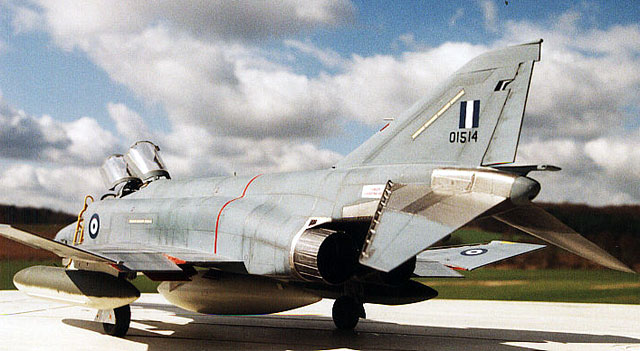|
The F-4E in Hellenic Air Force
Service - Part I
by Dr. Menelaos Skourtopoulos
|

|
|
McDonnell-Douglas F-4E Phantom II |
Aegean Blue F-4E Phantom II in 1/32 Scale

HyperScale is proudly supported by Squadron
Between 1974 and 1978, the Hellenic Air Force
received 58 new F-4Es and 8 new RF-4Es. In 1991 30 more used F-4Es came
from the Air National Guard, and finally 1994 27 ex Luftwaffe RF-4Es were
came to support the reconnaissance needs of the Nation. Four Sqs. was
equipped with the F/RF-4Es:
·
337 MPK (All weather Sq.) “Fantasma” (Phantom) based today
in Larissa AB (110 Combat Wing),
·
338 MDB (Fighter Bomber Sq.) “Aris” (Mars)
·
339 MPK (All weather Sq.) “Aias” (Ajax) based in Andravida
AB (117 Combat Wing) and
·
348 MTA (Tactical Rec. Sq.) “Matia” (Eyes) based also in
Larissa AB (110 Combat Wing).
In 1997 the Hellenic Aerospace Industries started
together with DASA an update Program for the modernization of 39 F-4Es
(all from the new F-4E batches) to make them flyable until 2010. This
project called Peace Icarus 2000 (I and II) and included a new radar
(AN/APQ-65), new colored multi function cockpit screens, AMRAAM and AIM-9M
capability, AFDS, friend/foe identification, and many more changes that
based at the F-4F ICE program. The program will make the Peace Icarus
Phantom a very dangerous adversary even for the newer and more advanced
“electric” jets of today.
The painting schemes found on Hellenic Phantoms
varied from the standard US SEA scheme to the new Ghost scheme.
The F-4
Phantom in 1/32 Scale
|
I won’t list all the F-4 kits in all scales. I’ll
write only about the big Phantoms in 1:32 scale.
There are two companies with 1:32 F-4s in the
market. Revell/Monogram and Tamiya. Almost all versions of the mighty
Phantom are available (the F-4E/F and RF-4C/E from Revell and the
F-4C/D/J/E from Tamiya) except the F/RF-4B and the British F-4K/M.

Both Revell and Tamiya Kits had their problems, but
all in all these are both very good kits, and you can build masterpieces
out of them.
For the F-4E, I used the Revell kit and started
with the F-4F because the F-4E is hard to find in Europe (and specially in
Germany!). On the other hand the F-4F kit offers very good seats but not
so good instrument panels as the F-4E kit and has not the slatted
stabilators. So I had to order them from the States because it is just
very difficult to make them from scratch (many thanks to Revell/Monogram
guys!). One more problem is the wrong nose of the F-4E/F kit but I could
live with it (in later F-4 kits, I made some changes to make it looking
better). Otherwise the kit is very good and offers almost everything to
make a superb model out of it.
I used six kits to cover all aircraft types and all
of the painting schemes that used by Hellenic Phantoms. Four F-4Fs
(converted into F-4Es) and two RF-4C (converted into RF-4Es).
Aegean Blue
Phantoms in Greek Service
|
I’ll start from the middle!
Greek Phantoms was flown back in the 1970s in the
SEA style scheme and had big light blue and white roundels in six
positions. In the mid 80es the paint scheme that was already used by the
Mirage F1 and the F-5A was also used by the F-4s. It was the Aegean Blue
(FS 35164) in all upper surfaces and silver (FS 17178) on the under
surfaces. The Aegean blue scheme was used until the recent days and it is
been replaced now with the new ghost scheme seen on the F-16s and F-5s.
There was a big misunderstanding about the right
tone of the Aegean blue. Is it darker or lighter? Well, Greek F-4s are
used many times a day and together with the Greek climatic conditions
makes the amount of weathering very high. The right tone of the Aegean
blue must be a much lighter one... but the right answer is very simple: If
it looks right it is right!
 As
I wrote above, the instrument panels are 3D, but not so good as in the
F-4E kit (especially the front panel). I used the Eduard photoetched kits
to make things better. The WSO panel was took from the kit but I added
some cables in the back and the shade of the radar screen. As
I wrote above, the instrument panels are 3D, but not so good as in the
F-4E kit (especially the front panel). I used the Eduard photoetched kits
to make things better. The WSO panel was took from the kit but I added
some cables in the back and the shade of the radar screen.
The back cockpit is too deep, so I had to cut it
and glue it 0.5cm higher. If you don’t change it, you’ll have to put the
seat much higher...Otherwise the situation in the cockpit is OK.
The seats that I found in the F-4F kit are very
good, but I changed them with resin ones from Paragon. I used only the
face curtains handles from the kit.
|
Home |
What's New |
Features |
Gallery |
Reviews |
Reference |
Forum |
Search